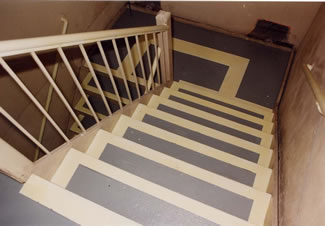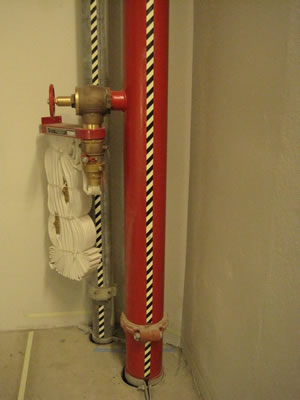When the first terrorist bomb attack happened at the New York City World Trade Center (WTC) in 1993, the explosion in the parking garage disabled the WTC’s main electrical power line and knocked out the emergency lighting. The smoke generated rose up to the 93rd floor of both WTC towers, even in the emergency staircases. It took building occupants hours to evacuate, many through smoke. Following these events, the owners of the twin towers, the Port Authority of New York and New Jersey installed photoluminescent exit path markings inside the emergency staircases in 1994: each step edge, each landing and the handrails on both sides were equipped with photoluminescent markings.

Photoluminescent step, landing and handrail markings as seen inside the former World Trade Center in lower Manhattan in 1994.
Seven years later when 9/11/2001 happened, these glow markings came to good use. NIST – the National Institute for Standards and Technology interviewed survivors of the 9/11 events and 33% of people in Tower 1 and 17% of people in Tower 2 mentioned the yellowish markings that aided their escape [http://wtc.nist.gov/NCSTAR1/PDF/NCSTAR%201-7.pdf ]. Based on the NIST recommendations, the City of New York soon implemented a range of new requirements after 9/11, including photoluminescent exit path markings in high-rise office building emergency staircases.
Since its 2009 edition, NFPA – National Fire Protection Association has non-electrical exit stair path marking requirements in Chapter 7: Means of Egress. Also in 2009, ICC – International Code Council added non-electrical, luminous egress path marking requirements for high-rise building staircases to its nationwide codes IBC – International Building Code and IFC – International Fire Code. The markings are required in buildings of groups A – assembly, B – business, E – educational, I – institutional, M – mercantile and R-1 – hotel/motel.
The markings get applied to each leading edge of a landing and on each step inside a staircase. The top surface of all handrails gets marked. Perimeter demarcation lines mark the egress path along all horizontal areas, i.e. on landings along the wall base and in any vestibules/ corridors that are part of the egress path. Obstacles that project more than 4 inches into the egress path get highlighted with a black-photoluminescent contrasting warning marking to avoid people bumping into a protrusion in the dark. Floor identification signs illuminate the stairway information. Doors from exit enclosures through which occupants must pass in order to complete their evacuation get marked all around on the door frame, the door hardware (push bar or door handle) gets highlighted and an emergency exit symbol sign (Man to the left or right) gets installed no higher than 18 inches above the floor.

Obstacles that project more than 4 inches into an egress path should be highlighted with a black-photoluminescent contrasting warning marking to avoid people bumping into a protrusion in the dark.
UL1994-listed photoluminescent egress path markings since 2009
The photoluminescent egress path markings are installed in low location to be visible underneath the smoke layer. During a building fire, typically smoke forms, rises under the ceiling and obscures the electrical lighting. Occupants shall drop to the floor where breathable air remains the longest and evacuate under the smoke layer. Down there, the photoluminescent floor proximity egress path markings are installed.
One important aspect is that these egress path markings are NON-electrical, so they work during power outages. Photoluminescent markings get activated by ambient lighting. They are typically UL1994-listed by an NRTL – Nationally Recognized Testing Laboratory like Underwriters Laboratories or ETL Intertek Testing. The markings get activated by only 1 foot-candle of ambient lighting and - just like electrical emergency lighting – get tested at 90 minutes in the dark. The markings then continue to emit their glow for hours to come until they get re-charged again by ambient lighting.
Markings to be installed on the floor, such as metal stair nosing and anti-slip tape additionally have to get UL410-floor suitability tested.
The new One World Trade Center in New York City is again getting equipped with photoluminescent exit path markings in the emergency staircases to make the high-rise building safer with lights on and off. The installation is already in progress.
Photos courtesy of American Permalight
Marina Batzke
Marina Batzke is General Manager of American Permalight, Inc., based in Torrance, California; incorporated since 1988; Manufacturers of Photoluminescent UL924-listed Signs and UL1994-listed Egress Path Markings. Marina Batzke is ASTM Committee E12.13 ‘Photoluminescent Safety Products’ Chair, member of the UL Standard Technical Panels UL924 and UL1994, and NFPA member.

